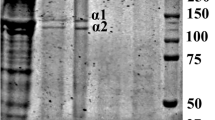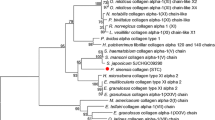Abstract
A low molecular weight type-II collagenous polypeptide (CIIp) from whale shark (WS) cartilage was prepared by thermolysin digestion; and examined for their physico-functional and antioxidant properties. The purified collagen was composed of an identical (α1)3 chains and was characterized as type-II. After hydrolysis with thermolysin, the α-chain of the WS collagen was degraded into smaller peptides with molecular weight ranging from 70 to 20KDa. CIIp was successfully separated from the hydrolysates with molecular weight of approximately 37 kDa. Amino acid analysis of CII, and CIIp indicated imino acid contents of 155 and 121 amino acid residues per 1000 residues, respectively. Differing Fourier transform infrared (FTIR) spectra of CII and CIIp were observed, which suggested that the hydrolysis process by thermolysin affected the secondary structure and molecular order of collagen, particularly the triple-helical structure. The denaturation temperature of CII (34 °C) was higher than that of CIIp. Low content of glycoprotein was observed in CII than CIIp due to removal of some polypeptides by thermolysin digestion. The antioxidant activity against 1,1-diphenyl-2-picrylhydrazyl radicals and the reducing power of CIIp was greater than that of CII. The results proposed that the purified CIIp from WS cartilage with excellent antioxidant activities could be the suitable biomaterial for therapeutic applications.




Similar content being viewed by others
References
Adler-Nissen J (1979) Determination of the degree of hydrolysis of food protein hydrolysates by trinitrobenzenesulfonic acid. J Agric Food Chem 27:1256–1262
Backlund J, Treschow A, Bockermann R, Holm B, Holm L, Issazadeh-Navikas S (2002) Glycosylation of type-II collagen is of major importance for T cell tolerance and pathology in collagen-induced arthritis. Eur J Immunol 32:3776–3784
Bergman I, Loxley R (1963) Two improved and simplified methods for the spectrophotometric determination of hydroxyproline. Anal Chem 35:1961–1965
Cao H, Shi FX, Xu F, Yu JS (2013) Molecular structure and physicochemical properties of pepsin-solubilized type-II collagen from the chick sternal cartilage. Eur Rev Med Pharmacol Sci 17:1427–1437
Chen L, Bao B, Wang N, Xie J, Wu WH (2012) Oral administration of shark type-II collagen suppresses complete Freund’s adjuvant-induced rheumatoid arthritis in rats. Pharm 5:339–352
Chi CF, Cao ZH, Wang B, Hu FY, Li ZR, Zhang B (2014) Antioxidant and functional properties of collagen hydrolysates from Spanish mackerel skin as influenced by average molecular weight. Molecules 19:11211–11230
Duan R, Zhang J, Du X, Yao X, Konno K (2009) Properties of collagen from skin scale and bone of carp (Cyprinuscarpio). Food Chem 112:702–706
Edwards HGM, Farwell DW, Holder JM, Lawson EE (1997) Fourier transform Ramanspectroscopy of ivory: II Spectroscopic analysis and assignments. J Mol Str 435:49–58
Ehrlich H (2015) Cartilage of marine vertebrates. Biol Mater Mar Orig 4:69–89
Gelse K, Poschl E, Aigner T (2003) Collagens-structure, function, and biosynthesis. Adv Drug Deliv Rev 55:1531–1546
Gibson GJ, Kielty CM, Garner C, Schor SL, Grant ME (1983) Identification and partial characterization of three low-molecular-weight collagenous polypeptides synthesized by chondrocytes cultured within collagen gels in the absence and in the presence of fibronectin. Biochem J 211:417–426
Gimenez B, Gomez-Estaca J, Aleman A, Gómez-Guillen MC, Montero MP (2009) Improvement of the antioxidant properties of squid skin gelatin films by the addition of hydrolysates from squid gelatin. Food Hydrocoll 23:1322–1327
He L, Cai S, Wu B, Mu C, Zhang G, Lin W (2012) Trivalent chromium and aluminum affect the thermostability and conformation of collagen very differently. J Inorg Biochem 117:124–130
He R, Girgih AT, Malomo SA, Ju X, Aluko RE (2013) Antioxidant activities of enzymatic rapeseed protein hydrolysates and the membrane ultrafiltration fractions. J Funct Foods 5:219–227
Hernandez-Ledesma B, Ramos M, Recio I, Amigo L (2006) Effect of β-lactoglobulin hydrolysis with thermolysin under denaturing temperatures on the release of bioactive peptides. J Chromatogr A 1116(1–2):31–37
Jeevithan E, Bao B, Bu Y, Zhou Y, Zhao Q, Wu WH (2014a) Type II collagen and gelatin from silvertip shark (carcharhinus albimarginatus) cartilage: isolation purification physicochemical and antioxidant properties. Mar Drugs 12:3852–3873
Jeevithan E, Wu WH, Wang N, He L, Bao B (2014b) Isolation, purification and characterization of pepsin soluble collagen isolated from silvertip shark (Carcharhinus albimarginatus) skeletal and head bone. Process Biochem 49:1767–1777
Jeevithan E, Jingyi Z, Wang N, He L, Bao B, Wu WH (2015) Physico-chemical, antioxidant and intestinal absorption properties of whale shark type-II collagen based on its solubility with acid and pepsin. Process Biochem doi:10.1016/j.procbio.2014.11.015
Jongjareonrak A, Benjakul S, Visessanguan W, Nagai T, Tanaka M (2005) Isolation and characterisation of acid and pepsin-solubilised collagens from the skin of brownstripe red snapper (Lutjanusvitta). Food Chem 93:475–484
Kittiphattanabawon P, Benjakul S, Visessanguan W, Nagai T, Tanaka M (2005). Characterisation of acid-soluble collagen from skin and bone of bigeyesnapper (Priacanthustayenus). Food Chem 89: 363–372
Kittiphattanabawon P, Benjakul S, Visessanguan W, Shahidi F (2010) Isolation and characterization of collagen from the cartilages of brownbanded bamboo shark (Chiloscylliumpunctatum) and blacktip shark (Carcharhinuslimbatus). LWT Food Sci Technol 43:792–800
Klompong V, Benjakul S, Kantachote D, Shahidi F (2007) Antioxidative activity and functional properties of protein hydrolysate of yellow stripe trevally (Selaroides leptolepis) as influenced by the degree of hydrolysis and enzyme type. Food Chem 102:1317–1327
Laemmli UK (1970) Cleavage of structural proteins during the assembly of the head of bacteriophage T4. Nature 227:680–685
Li Y, Jiang B, Zhang T, Mu W, Liu J (2008) Antioxidant and free radical-scavenging activities of chickpea protein hydrolysate (CPH). Food Chem 106:444–450
Lima OC, Figueiredo CC, Pereira BAS, Coelho MGP, Morandi V, Lopes-Bezerra LM (1999) Adhesion of the human pathogen Sporothrixschenckii to several extracellular matrix proteins. Braz J Med Biol Res 32:651–657
Lundin K, Holmgren S (1989) The occurrence and distribution of peptide- or 5-HT-containing nerves in the swimbladder of four different species of teleosts (Gadus morhua, Ctenolabrus rupestris, Anguilla anguilla, Salmo gairdneri). Cell Tissue Res 257:641–647
Mendis E, Rajapakse N, Byun HG, Kim SK (2005) Investigation of jumbo squid (Dosidicusgigas) skin gelatin peptides for their in vitro antioxidant effects. Life Sci 77:2166–2178
Merly L, Smith SL (2013) Collagen type-II alpha 1 protein: a bioactive component of shark cartilage. Int Immunopharmacol 15:309–315
Montero P, Gomez-Guillen MC (2000) Extracting conditions for megrim (Lepidorhombus boscii) skin collagen affect functional properties of the resulting. J Food Sci 65:434–438
Muyonga JH, Cole CGB, Duodu KG (2004) Characterisation of acid soluble collagen from skins of young and adult Nile perch (Latesniloticus). Food Chem 85:81–89
Myers LK, Sakurai Y, Rosloniec EF, Stuart JM, Kang AH (2004) An analog peptide that suppresses collagen-induced arthritis. Am J Med Sci 327:212–216
Nagai T, Suzuki N, Nagashima T (2008) Collagen from common minke whale (Balaenopteraacutorostrata) unesu. Food Chem 111:296–301
Rochdi A, Foucat L, Renou JP (2000) NMR and DSC studies during thermal denaturation of collagen. Food Chem 69:295–299
Ronnestad I, Murashita K, Kottra G, Jordal AE, Narawane S, Jolly C et al (2010) Molecular cloning and functional expression of atlantic salmon peptide transporter 1 in Xenopus oocytes reveals efficient intestinal uptake of lysine-containing and other bioactive Di- and tripeptides in teleost. Fish J Nutr 140:893–900
Sadowska M, Kolodziejska I, Niecikowska C (2003) Isolation of collagen from the skins of Baltic cod (Gadusmorhua). Food Chem 81:257–262
Schmid TM, Conrad HE (1982) A unique low molecular weight collagen secreted by cultured chick embryo chondrocytes. J Biol Chem 257:12444–12450
Shimada K, Fujikawa K, Yahara K, Nakamura T (1992) Antioxidative properties of xanthan on the autoxidation of soybean oil in cycloextrin emulsion. J Agric Food Chem 40:945–948
Tang CH, Wang XS, Yang XQ (2009) Enzymatic hydrolysis of hemp (Cannabis sativaL.) protein isolate by various proteases and antioxidant properties of the resulting hydrolysates. Food Chem 114:1484–1490
Veeruraj A, Arumugam M, Balasubramanian T (2013) Isolation and characterization ofthermostable collagen from the marine eel-fish (Evenchelysmacrura). Process Biochem 48:1592–1602
Wang L, Liang Q, Chen T, Wang Z, Xu J, Ma H (2014) Characterization of collagen from the skin of Amur sturgeon (Acipenserschrenckii). Food Hydrocolloids 38:104–109
Whitmore L, Wallace BA (2008) Protein secondary structure analyses from circular dichroism spectroscopy: methods and reference databases. Biopolymer 89:392–400
Wong DWS (1989) Mechanism and theory in food chemistry. Van Nostrand Reinhold Company Inc, New York, p 428
Xi C, Tan L, Sun Y, Liang F, Liu N, Xue H et al (2009) A novel recombinant peptide containing only two T-cell tolerance epitopes of chicken type-II collagen that suppresses collagen-induced arthritis. Mol Immunol 46:729–737
Xie J, Ye HY, Luo XF (2014) An efficient preparation of chondroitin sulfate and collagen peptides from shark cartilage. Int Food Res J 21:1171–1175
Zhou DY, Tang Y, Zhu BW, Qin L, Li DM, Yang JF et al (2012) Antioxidant activity of hydrolysates obtained from scallop (Patinopectenyessoensis) and abalone (Haliotis discus HannaiIno) muscle. Food Chem 132:815–822
Zhu B, Dong X, Zhou D, Gao Y, Yang J, Li D et al (2012) Physicochemical properties and radical scavenging capacities of pepsin-solubilized collagen from sea cucumber (Stichopus japonicas). Food Hydrocolloids 28:182–188
Acknowledgments
This work received financial support from National High Technology Research and Development Program of China (No. 2011AA09070109) and National Natural Science Foundation of China (No. 81341082).
Author information
Authors and Affiliations
Corresponding authors
Rights and permissions
About this article
Cite this article
Jeevithan, E., Bao, B., Zhang, J. et al. Purification, characterization and antioxidant properties of low molecular weight collagenous polypeptide (37 kDa) prepared from whale shark cartilage (Rhincodon typus). J Food Sci Technol 52, 6312–6322 (2015). https://doi.org/10.1007/s13197-015-1715-5
Revised:
Accepted:
Published:
Issue Date:
DOI: https://doi.org/10.1007/s13197-015-1715-5




